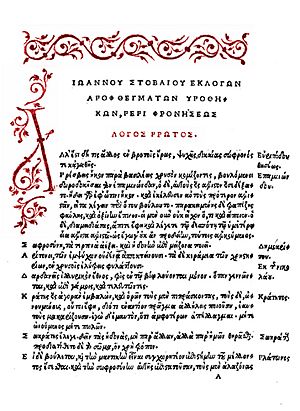Stobaeus facts for kids
Joannes Stobaeus (pronounced Yo-AN-nes Sto-BAY-us) was a Greek writer who lived around the 400s AD. He came from a place called Stobi in Macedonia. Stobaeus is famous for collecting many important writings from other Greek authors. His big collection is called the Anthology.
This Anthology was originally split into two main parts, each with two books. Over time, these parts got separated. The first part became known as the Extracts or Eclogues, and the second part was called the Anthology or Florilegium. Today, modern books refer to the whole collection as the Anthology.
The Anthology contains pieces from hundreds of different writers. These include poets, historians, speakers, philosophers, and even doctors. The topics covered are very wide. They range from ideas about nature and how to think clearly, to good behavior, politics, and wise sayings for daily life. Stobaeus's work is very important because it saved parts of many old books and writers that we wouldn't know about today.
Contents
Who Was Joannes Stobaeus?
We don't know much about Stobaeus's personal life. His last name, Stobaeus, probably means he was from the city of Stobi. We can't say exactly when he lived, but he quoted writers from the early 400s AD. This means he likely lived around that time.
Some people think he wasn't a Christian because he didn't mention Christian writers. However, his name might suggest he was a Christian, or at least that his parents were.
Stobaeus's Important Collection
Stobaeus's Anthology is a very valuable collection of writings from earlier Greek authors. He gathered these pieces and organized them by subject. He wanted to create a helpful book of wise and useful sayings.
In most old copies of his work, it's divided into three books. The first two books were one work called Physical and Moral Extracts. The third book was another work called Florilegium or Anthology.
Stobaeus made this collection for his son, Septimius. He even wrote a letter at the beginning explaining what the book was for. We know from an old text by Photius (from the 800s AD) that the work was first divided into four books and two volumes. The third book we have today actually combines two of his original books.
The full title of his work, according to Photius, was Four Books of Extracts, Sayings and Precepts. Later, the two main volumes were separated. They became known in Europe as the Eclogae and the Florilegium. Modern versions now call the whole work the Anthology.
The very beginning of his work, which talked about how important philosophy is, is mostly lost. The second book is also mostly missing. The third and fourth books were combined and changed. Each chapter in his four books has a title that tells you what it's about.
Stobaeus quoted more than 500 different writers. He usually started with poets, then moved to historians, speakers, philosophers, and doctors. Many of the original works he quoted are now lost. Because of Stobaeus, we still have many important pieces from ancient Greek plays. For example, he quoted over 500 passages from Euripides, 150 from Sophocles, and over 200 from Menander.
What's in Books 1 and 2?
The first two books of Stobaeus's Anthology are called the "Eclogues." They mostly contain writings from earlier poets and writers about:
- Physics: This meant ideas about nature and the world.
- Dialectics: This was about how to argue and think clearly.
- Ethics: This covered ideas about good behavior and morals.
We know that the first book originally had an introduction about the benefits of philosophy. It also talked about different schools of philosophy and old ideas about geometry, music, and math. Most of this introduction is now lost. The first book had sixty chapters, and the second had forty-six. Sadly, only the first nine chapters of the second book still exist in most copies. Some missing parts have been found in other old collections.
Sometimes, Stobaeus's understanding of "physics" (in the ancient Greek sense) wasn't always correct. He sometimes mixed up ideas from different philosophical groups, like Platonism and Pythagoreanism. For parts of the first book and much of the second, he used information from the lost works of philosophers like Aetius and Arius Didymus.
What's in Books 3 and 4?
The third and fourth books of the Anthology are called the "Florilegium." These books focus on:
- Moral topics: Ideas about right and wrong.
- Political topics: Ideas about government and society.
- Economic topics: Ideas about managing money and resources.
- Practical wisdom: Wise sayings for everyday life.
The third book originally had forty-two chapters, and the fourth had fifty-eight. These two books, like much of the second, deal with ethics. The third book looks at virtues (good qualities) and vices (bad qualities) in pairs. The fourth book covers more general ethical and political subjects. It often quotes different views on a question in two chapters right after each other.
See also
 In Spanish: Estobeo para niños
In Spanish: Estobeo para niños


